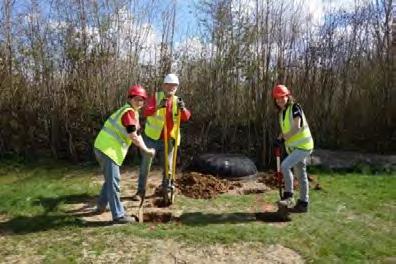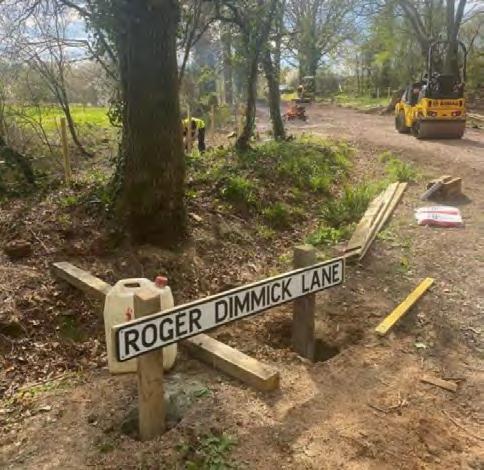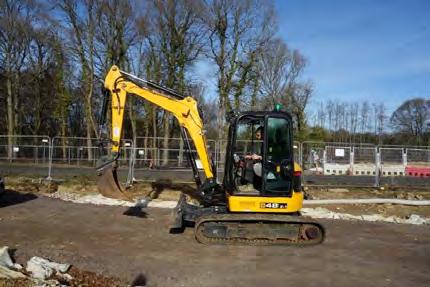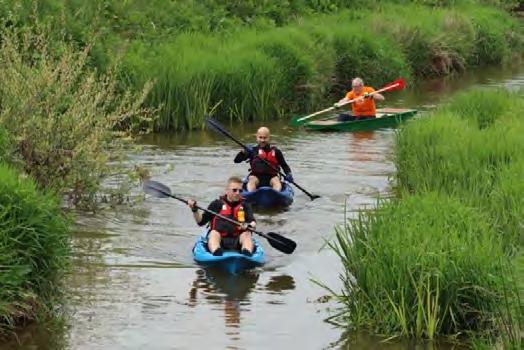
6 minute read
Wey & Arun Canal Trust Page
21
While I was investigating a report of a tree that had come off the worse for wear in yesterday’s blustery conditions, I came across some fairly unusual sights. That’s the great thing about the Navigation, you don’t have to go far, even in the relatively populated areas, to find something interesting. A group of bachelor mallards had a tufted duck tagging along. I don’t get too many of those on my stretch. All my local tufties prefer the lakes on the golf course so he was nice to see.
May – Waiting for Cygnets and a knock on the
door. This year’s local potential swan parents are sitting well and we are hopeful of cygnets soon. Last year they managed to rear 3 to almost adulthood although they lost 2 fairly late and only one made it through to adulthood. Hopefully they have or soon will find a mate of their own. I have recently invested in some floating duck and swan pellets. It’s a little more convenient than defrosting and sharing all my frozen sweetcorn and petits pois. They seem to be a hit. I fed them on the backwater behind the house earlier. A couple of hours later one of them turned up on the towpath at my back gate. It’s the first time I’ve seen them there. They clearly know where I live!
When we lived on the boat the local swans knew which residents were the early birds, if you’ll pardon the pun, and knocked on the sides of the boats to request breakfast. My husband always called them the mafia; it did feel like they were demanding food with menaces. The geese and ducks always asked much more politely. With that in mind, I am convinced it won’t be long until they are pecking on the door for a snack. If they train the youngsters I think this might be a good few years worth of trouble I’ve made for us. I don’t think 5 litres of pellets is going to be enough! Well, it’s good to keep in with the neighbours.
Wey and Arun Canal Trust
WACT News
WRG weekend camp helps upgrade slipway for visiting youth groups
Thanks to the efforts of visiting teams from London WRG and KESCRG, along with Wey & Arun Canal Trust volunteers, youth groups using the canal to launch canoes at Drungewick now have much improved facilities.
22
Roger Dimmick Lane is used regularly by groups including Scouts, Sea Scouts and the local Renegades youth club to access the slipway and at times it could get muddy. Teams from London WRG and KESCRG spent a weekend working here, laying a new road surface and erecting new fencing and signage. Some 80 tons of type 1 stone was laid over two days to improve the track, making parking and loading and unloading canoes a lot easier. Volunteers also made a start on a new timber picnic bench, created from wood from the Tickner’s Heath road crossing project in Alfold. The use of the canal for paddling has grown hugely over recent years and a local firm Fluid Adventures now operates from the slipway at weekends and school holidays, offering a hire service for a range of canoes and kayaks. Those with their own canoes, kayaks, rowing boats and paddleboards are also welcome to use the canal (a day licence is needed or British Canoeing members go free).
Tickner’s Heath project opens for visitors:
Volunteers have made good progress at the Tickner’s Heath road crossing in Alfold and at the end of April opened the pedestrian footbridge as a viewing platform for the public to see the work going and Surrey’s newest length of canal. The project to divert the canal and create a new road crossing began in late 2020, with contractors installing the pilings and the prefabricated steel bridge deck for the pedestrian footbridge. Volunteers have undertaken the rest of the construction. A road diversion is needed before work on the road bridge itself can begin and volunteers have been pushing on to get as far as they can with creating a temporary road while awaiting the Section 278 agreement from Surrey County Council. If you want to take a look, head to the Forestry Commission car park at Sidney Wood (GU6 8HU).

Switching from red to green: The Trust has been trialling the use of HVO (hydrotreated vegetable oil) in some of its plant and van fleet following the ban on red diesel. The synthetic HVO being used is made from 100% renewable waste fats and vegetable oils and claims to be better for the environment than regular diesel,
23
reducing net CO2 greenhouse gas emissions by as much as 90%. As well as significantly reducing greenhouse gases the fuel is biodegradable and safe to use near water, so a good choice for us. The fuel is best used in newer machinery so for now it is used in the telehandler, small digger, cement mixer, jet wash and large digger, as well as restoration site supervision manager Dave Evans’ work van.
The cost of the fuel works out at roughly the same as regular diesel, but can be stored for up to 10 years. Dave Evans reports that so far the switch has worked well. “So far we’ve had no problems whatsoever but it does smell a bit like a chip shop sometimes - it has a very different smell to diesel.” The Trust is already using the cleaner Aspen fuel in its lawnmowers, strimmers and power tools as the fuel is 99% cleaner than ordinary petrol. Being virtually free from sulphur, benzene and solvents, it means the fuel does not have the usual pungent petrol smell, making it more pleasant for volunteers to use.
River Rally: The Wey & Arun Canal Trust held its annual River Arun Rally on Sunday May 15th, inviting small craft to join the paddle along the picturesque river in West Sussex. This annual event aims to demonstrate the right of navigation on the River Arun. Each year canoeists, kayakers and paddleboarders travel from Pulborough as far upstream as the tidal Pallingham Quay, helping to ensure that when restoration of the Wey & Arun Canal is complete there will be no legal reason why boats cannot venture from the canal into the Arun. The rally began in 1983 and the event has been run by the Wey & Arun Canal Trust since 2011, celebrating the long tradition of boats navigating a river which was once part of a waterway route from London to the South Coast. The number of people using the waterway has been increasing year on year as the popularity of paddleboarding and kayaking has grown, and Trust volunteers have created dedicated landing stages at the longest restored section in Loxwood, West Sussex. The trip from Pulborough and Stopham to the tidal limit at Pallingham typically takes three and a half hours and the rally is open to all.










